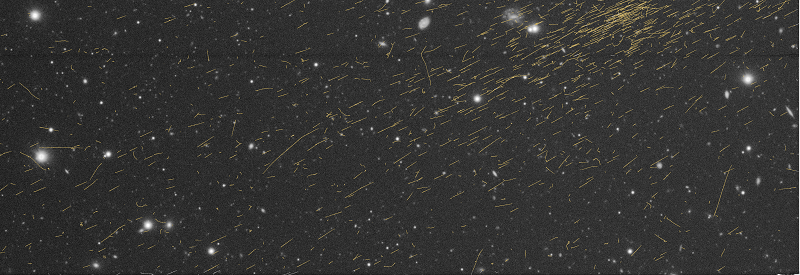Showers in bathrooms provide comfort; showers from space provide delight to astrophysicists. Osaka Metropolitan University scientists have seen cosmic-ray widespread air showers with unparalleled accuracy using their revolutionary technology, opening the door to fresh insights into the Universe’s most energetic particles.

Cosmic-ray extensive air shower captured by the Subaru Telescope. An example of a cosmic-ray extensive air shower recorded by the Subaru Telescope. The highlighted tracks, which are mostly aligned in similar directions, show the shower particles induced from a high-energy cosmic ray. Image Credit: National Astronomical Observatory of Japan, Hyper Suprime-Cam (HSC) Collaboration
When a high-energy cosmic ray collides with the Earth’s atmosphere, it produces a massive number of particles known as an extended air shower.
A research team led by Associate Professor Toshihiro Fujii from Osaka Metropolitan University’s Graduate School of Science and Nambu Yoichiro Institute of Theoretical and Experimental Physics, along with graduate student Fraser Bradfield, observed that the prime-focus wide field camera mounted on the Subaru Telescope, which is located atop Hawaii’s Mauna Kea volcano, can capture these extensive air showers with a remarkable resolution.
The Subaru Telescope was created to be used for observational astronomy. Cosmic rays, which appear as “tracks” on observed images and obscure the target stars or galaxies, are rejected as noise by standard astronomical data processing.
However, the study of this team focuses on that very “noise.” The study team identified 13 images with large air showers after analyzing nearly 17,000 images recorded between 2014 and 2020. These images had much more particle trails than usual.
With conventional observation methods, it is challenging to distinguish between the types of particles that constitute extensive air showers. Our method, on the other hand, has the potential to determine the nature of individual particles.
Toshihiro Fujii, Associate Professor, Graduate School of Science, Osaka Metropolitan University
Fujii added, “Furthermore, by integrating our method with conventional approaches, we hope to advance our understanding of extensive air showers. This technique may allow us to search for dark matter or other exotic particles, offering additional insights into the transition of the Universe into a matter-dominated era.”
The study was made possible by JSPS KAKENHI Grant Numbers 20H00181, 20H05856, 22K21349, and JP20H05852. JST funded this effort through the development of university fellowships for the creation of science and technology innovation, Grant Number JPMJFS2138.
Journal Reference
Kawanomoto, S., et al. (2023) Observing cosmic-ray extensive air showers with a silicon imaging detector. Scientific Reports. doi:10.1038/s41598-023-42164-4